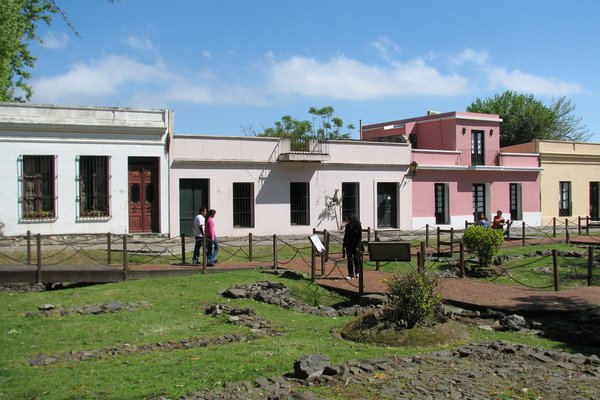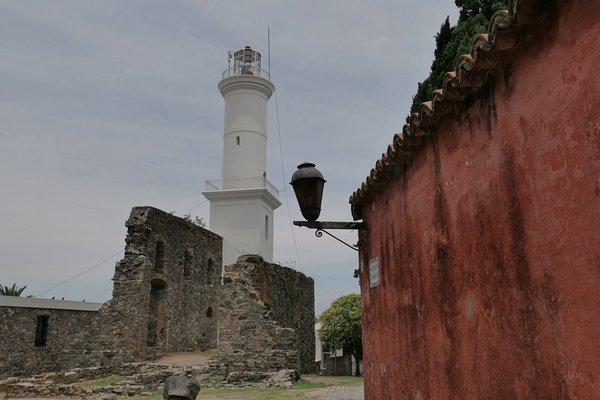Uruguay
Colonia del Sacramento
The Historic Quarter of the City of Colonia del Sacramento comprises a colonial urban landscape where Portuguese and Spanish traditions are combined.
Colonia lies in a strategic position at the tip of a peninsula in the Río de la Plata. It changed hands between the two European powers a couple of times between the 17th and 19th centuries. The townscape is characterized by its organic street plan, cobbled streets and low, modest buildings.
Community Perspective: Easily accessible by hydrofoil from Buenos Aires; expect a laid-back atmosphere and a lack of noteworthy sights.
Site Info
Official Information
- Full Name
- Historic Quarter of the City of Colonia del Sacramento (ID: 747)
- Country
- Uruguay
- Status
-
Inscribed 1995
Site history
History of Colonia del Sacramento
- 1995: Inscribed
- Inscribed
- Type
- Cultural
- Criteria
- iv
Links
- UNESCO
- whc.unesco.org
- Official
-
- coloniauy.com — Colonia del Sacramento
All Links
UNESCO.org
- whc.unesco.org — whc.unesco.org/
Official Website
- coloniauy.com — Colonia del Sacramento
Community Information
- Community Category
- Urban landscape: Colonial
Travel Information
Recent Connections
-
Perfect Inscriptions
1995 -
Seven Years' War
During the Seven Years war a reluctant … -
Built or owned by Spanish
The current building of the Basilica de…
Connections of Colonia del Sacramento
- Individual People
-
-
Charles Darwin
November 17th."We crossed the Rozario, which was deep and rapid, and passing the village of Colla, arrived at mid-day at Colonia del Sacramiento." -
Garibaldi
Occupied by Garibaldi in 1845 when leading an "Italian Legion" (He also led the Uruguayan navy!) in the Uruguayan Civil War figthing on the side of the liberal "Colorados" against the "Blancos" of Manuel Oribe
-
- Trivia
-
-
Built or owned by Portuguese
fortifications -
Built or owned by Spanish
The current building of the Basilica del Santisimo Sacramento was erected under Spanish rule: The present temple dates back to 1810, when it was built according to plans by Tomás Toribio (wiki)See en.wikipedia.org
-
- History
-
-
Sieges and Battles
Several times, by the Spanish -
Seven Years' War
During the Seven Years war a reluctant Spain joined the French side in 1761. Portugal was a British ally and in 1762 Spain attempted an invasion of Portugal and also attacked and captured Colonia del Sacramento (then a Portuguese colony). The town was returned to Portugal shortly afterwards and underwent several more transfers between Portugal and Spain, even becoming a part of independnet Brazil before finally joinin an independent Uruguay. -
Fusion
"successful fusion of the Portuguese, Spanish and post-colonial styles"
-
- Damaged
-
-
Destroyed during invasion
By Spain in 1704/5
-
- World Heritage Process
-
-
Perfect Inscriptions
1995 -
Extensions on Tentative List
Insular area and bay of Colonia del Sacramento -
Inscribed on a single criterion only
iv. to be an outstanding example of a type of building, architectural or technological ensemble or landscape which illustrates (a) significant stage(s) in human history -
First inscriptions
Uruguay 1995
-
- Religion and Belief
-
-
Mikveh
Ruins of a possible mikveh dating back as far as the early 1700s -
Jewish religion and culture
Mikveh -
Franciscan Order
The remains of a Franciscan monastery
-
- Human Activity
- Constructions
-
-
Lighthouses
19C, coastal
-
- Timeline
-
-
Built in the 17th century
Founded by the Portuguese in 1680
-
News
No news.
Recent Visitors
Visitors of Colonia del Sacramento
- AC
- Adrian Turtschi
- Alberto Rodriguez Gutierrez
- Alejandro Lau
- Alexander Barabanov
- Alexander Lehmann
- Alex Marcean
- Ali Zingstra
- Ammon Watkins
- Ana
- Ana Lozano
- arnaugir
- Artsybrea
- Assif
- Atila Ege
- basementonline
- Bill Maurmann
- Bodil Ankerly
- bogbb
- Bram de Bruin
- Carlos Sotelo
- Cezar Grozavu
- Christoph
- Christravelblog
- Cirene Moraes
- Claire Bradshaw
- Colossus
- Crinion
- ctravel
- Cyberczar
- CynthiaSam
- Daniela Hohmann
- Daniel Chazad
- del
- Dennis Nicklaus
- DjhMck
- Don Irwin
- Doubanjiang
- DouglasR
- Els Slots
- Emili Xaus
- Erik G
- Eva Kisgyorgy
- Fan Yibo
- Feldhase
- Felicité
- Filip Murlak
- Frédéric M
- George Gdanski
- Gernot
- Grendel Gongan
- Grzegorz Andruszkiewicz
- Harry Mitsidis
- Hdwilsonau
- hotpickle
- Hurrvinek
- Iain Jackson
- IreneKD
- Jacob Choi
- Jan Zimmermann
- Jarek Pokrzywnicki
- Jawnbeary
- Jay T
- Jean Lecaillon
- Jens
- J_neveryes
- João Aender
- Joel on the Road
- Jon Eshuijs
- Jon Opol
- Karito Vies
- KeithBailey
- Kevin247
- kiank37
- Kjlauer
- Krijn
- Kurt Lauer
- Lauren Gurnee
- leroykstlj
- Liamps91
- Linz
- Loic Pedras
- Lucio
- Luis Filipe Gaspar
- Lukasz Palczewski
- lynnz317@aol.com
- Maciej Gil
- Maja
- Mariam
- Martin
- Max
- Michael Ayers
- Michael Novins
- michaelsballard
- Michael Turtle
- Mihai Dascalu
- Mikko
- MMM
- Morodhi
- nan
- Nihal Ege
- Paola Laura
- Patrik
- Patrik_globe
- petar
- Petteri
- Philipp Leu
- Philipp Peterer
- phillipmeng
- Pink Bunny
- puessergio
- Rachel Perkins
- Reza
- Roman Bruehwiler
- saraleonela
- Sclowitz
- Sergio Arjona
- Shandos Cleaver
- Simonf
- Solivagant
- Squiffy
- Stanislaw Warwas
- Sutul
- Tamara Ratz
- Tevity
- Thomas Buechler
- Thomas van der Walt
- Tim Allen
- Timonator
- Timothy C Easton
- Traveling Girl
- triathlete_16
- Truls Brekke
- ValiaVeweth
- Vernon Prieto
- Veronica
- Vsacan
- Walter
- Waxwing
- Wojciech Fedoruk
- Xiquinho Silva
- Yi Han Goh
- zfish
- Zoë Sheng
Community Reviews
Show full reviews
Like many other people's experience, I would agree that at first glance Colonia does not have many things to do. However, for me personally, it was a much-needed respite after the hustle and bustle of Buenos Aires and Santiago. My family and I stayed at a quaint hotel for three nights near the city center, and we spent our days walking through the town and basking in the peacefulness and quiet that Colonia offers.
The town is walkable, although the streets themselves can be a little precarious since they are very old and cobbled so if you have mobility issues take caution! We entertained ourselves by stopping by shops, visiting the paper museum, having high tea, and getting a guided South American bird tour throughout the town!
Although it may not be the most exciting heritage site, I have found that Colonia is always one of the first places I recommend to those who are planning South America trips. It's such a picturesque town, and I hope to be back soon.
Keep reading 0 comments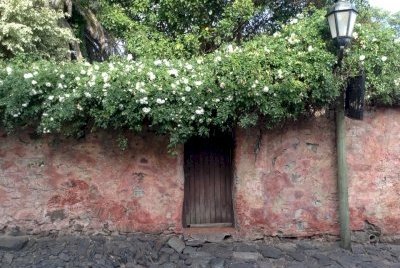
There are no impressive sights or first-class attractions in Colonia del Sacramento. There are no large convents, nor cathedrals. There are no old mansions or prominent civil buildings to keep in mind before traveling. I would even say that there is not a single building that reflects a distinctive urban, architectural or artistic identity. Almost any Latin American colonial city has more things to see and do than this picturesque little Uruguayan town.
However, Colonia is a charming city. Its location on the banks of the Río de la Plata, the quietness of its cobbled streets and the friendliness of the locals make the visit worthwhile. The atmosphere is laid back and there are plenty of good restaurants and high-end souvenir shops. The famous Calle de los Suspiros is indeed very photogenic; like the whole city, which is always impeccable.
Colonia is a historical crossroads, a changing frontier. First, between the Spanish and Portuguese empires; then, between Brazil and Uruguay. This is evident in the presence of some Portuguese and Spanish colonial style houses. However, the vast majority of the city's architecture belongs to the independent period (19th and 20th centuries), although it is harmoniously integrated into the original colonial landscape.
There are many museums in Colonia, but most only have a couple of rooms and very small collections. I recommend visiting the Museo Casa de Nacarello, the Museo de los Azulejos and the Museo Municipal. Altogether, they add up to two hours of visit and are …
Keep reading 0 comments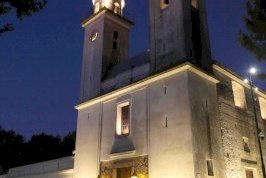
I arrived at night in the very cheap but nice Toca Madera Hostel close to the Bus Terminal and the Barrio Historico which is the WHS on a small peninsula. The rest of Colonia lies aside the peninsula, but I didn't visit. The Barrio Historico is really full of nice looking restaurants and cafés which lie below the many poplars all around the place. In the Deli de las Rosas I ate a really nice yoghurt with muesli and fruits for low price. Really recommendable. In the evening I also had a nice but expensive dinner in a beautiful patio in the nice summer air. But enough of the food ads- I of course had a walk around the Barrio also. However I did not take use of the two tourist information centres. A small one is on the south side of the peninsula and a larger one just at the Ferry Terminal. The are some signs spread around the city explaining some things about the original settlement. At the Plaza Manuel Lobo there is the church and the foundation walls of a Portugease Government Building. After visiting the church I went to the yacht harbour and had a look around. Then I walked all the way along the water to the ferry terminal, which is nice and a few historic remains can be seen like the old defensive building of San Miguel. On the way back from the terminal I went through a re-built town gate with a draw …
Keep reading 0 comments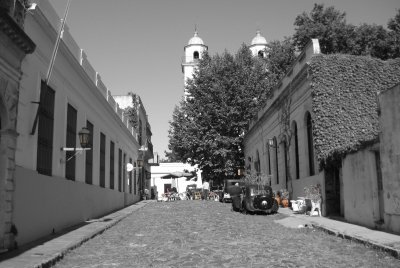
What Colonia del Sacramento lacks in single sights it makes up for atmosphere. You can climb the lighthouse, visit a small Basílica and walk along the Muelle de Puerto de Yates but what will remain are general memories of a picturesque, laid back and ageing townscape.
Overall well worth the detour from Buenos Aires (with the Buquebus ferry) or Montevideo.
Keep reading 0 comments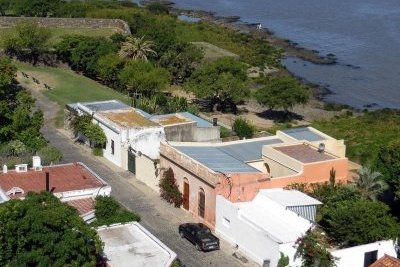
The Historic Center of the City of Colonia del Sacramento in Uruguay is a perfectly adequate World Heritage Site, but, as has been intimated by other reviewers here, it would likely not fall in the top tier for many WHS travelers. Like others, I visited the town as a day trip by ferry from Buenos Aires in March 2016. The weather was warm, which made the stroll around the historic cobblestone streets of the historic quarter rather pleasant. I appreciated the tile maps of the city found throughout the historic quarter, and also enjoyed the overhead views of the city from atop the lighthouse. Scattered around the quarter were several old cars that had been turned into artwork, and antique lamps were hung from the sides of many of the buildings. Before returning to Buenos Aires, my friends and I enjoyed a relaxing late lunch at a cafe overlooking the Rio de la Plata and some of the old city walls on the south side of the historic quarter. Although my visit to Colonia del Sacramento gave me an opportunity to see Uruguay for the first time, I think I'll have to return for a longer visit some day to get a better feel for the rest of the country.
Logistics: Colonia del Sacramento is accessible by ferry from Buenos Aires; the historic quarter is a short walk from the ferry terminal in Uruguay. Be sure to plan time to go through customs in both countries.
Keep reading 0 comments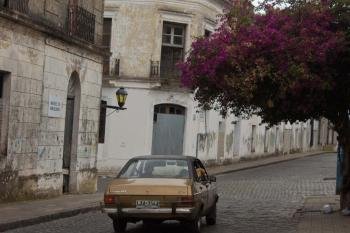
I am a bit torn about my view on the town. It is quaint and cute but I also found it a little boring. Maybe I was missing something but it wasn't as photogenic as I was hoping and there weren't a lot of things to do. I only stayed one night and felt like that was long enough.
It certainly was not a bad experience - just not particularly memorable.
Keep reading 0 comments
I went to Colonia del Sacramento in March 2013, arriving - unusually - by air. Once our Cub had landed at Colonia's airfield we had to call customs and wait for them to drive over from the town's port in order to stamp our passports. They even gave us a lift into town!
Colonia is a small, low-key affair - not the most interesting WHS in the world. Nevertheless it is a pleasant enough place, and is interesting for its history of contested control by the Spanish and Portuguese colonialists. This is manifested in the different cambers you can see on various streets - here a normal camber with the hump in the middle of the road, there a reverse camber with a dip in the middle of the road!
Uruguay has since been joined on the list by the Fray Bentos Industrial Landscape, which I'd guess might be a bit bleak. But I'll be interested to read the first review when someone on this site visits it.
Keep reading 0 comments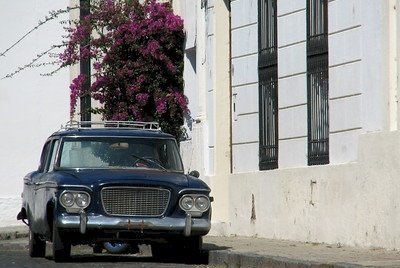
Colonia is the antithesis of Buenos Aires (BA): while the Argentinian capital has grown into a modern city of millions, its Rio de la Plata neighbour has turned into a quiet backwater. BA looks to have taken the better road economically, but Colonia has beaten them at least on one aspect: it has gained world heritage status, something BA still only can hope for.
I 'did' Colonia the way most people do - by ferry from BA. This is a very easy way to pick up a new country also, although I can't really say that I've learned to know the soul of Uruguay after a one-day visit. I didn't even touch Uruguayan pesos: I tried to get hold of them but all the banks were closed and the only ATM I could find didn't like my card. So I just paid in Argentinian pesos and even got the change back in that currency. One thing is different though: there's a one-hour time difference between Uruguay and Argentina (although that's only temporary)!
So what's to see? The main thing that struck me was the general laid-back atmosphere, softened even more by the leafy streets and abundance of flowers. One just has to walk around slowly, admire the nice little old buildings and have a meal or a drink. A couple of houses are turned into little museums, which are worth a look. In one of those I encountered a fossilized Glyptodon - that's a very big and scary-looking …
Keep reading 0 comments
Just surfing through the site, while working in Indonesia, I see another review of Paul Tanner. Again he wonders if inscription is justified just like the one of Caves of the Aggtelek and Slovak Karst. Maybe Paul is a bit too critical, I've been in Colonia del Sacramento as well and must say the atmosphere felt just good, very good, feeling back in time even when life was more relaxed. Good memories I have of CdS.
Keep reading 0 comments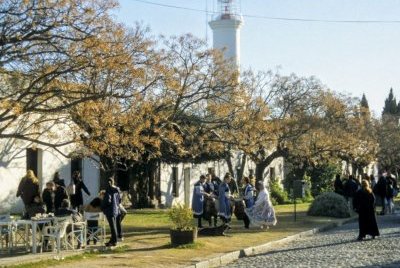
Currently Uruguay possesses but a single WHS : at Colonia Del Sacramento on the banks of the River Plate. In summer 1999 we were journeying from Buenos Aires to Iguassu and didn’t want to miss such a close new (for us) country with another WHS so took an indirect route by hydrofoil across the Plate. The next day we continued by bus through the rolling pastures of Uruguay via Fray Bentos (not then even on Uruguay's T List) to cross back into Argentina at the Salto-Concordia frontier.
On arriving at Colonia the vast majority of hydrofoil passengers jumped onto waiting busses and continued to Montevideo. We found ourselves in a small town with plenty of hotels and restaurants and obviously heavily dependent on serving Porteno tourists - so many indeed that we had problems finding an unbooked room.
The town is pleasant enough with a number of cobbled streets bounded by low houses in colonial style together with a few ruins in the form of town walls/gates overlooking the River Plate (it is said that the lighthouse is the only “high building” -photo). The town is supposed to reflect in its layout and architecture its origins as the most southerly Portuguese colonial settlement but I can’t say that this aspect was particularly noticeable to us. It was originally founded in 1680 and changed hands a few times before its final incorporation into the Spanish empire in 1777.
It was a pleasant stop-over but whether the town really …
Keep reading 0 comments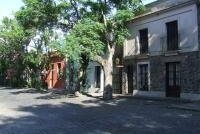
After the noise and pollution of Buenos Aires across the river, Colonia was a breath of fresh air. So laid back and relaxing. On the wide, tree-lined streets even the motor vehicles were in keeping with the surrounding buildings; not a car to be seen built after 1950!
We went across the river on an early ferry, and it was like entering a ghost town. But around 11am the locals began to appear, and very friendly they were too.
We loved the colourful old Portuguese cottages around the Plaza Mayor, and the pinted blue tiles that appeared everywhere.
Keep reading 0 comments
Colonia was WONDERFUL. Eating outside in the quaint, warm and friendly cafes was an experience we shall never forget. Our children (ages 6 & 12) loved Colonia as much as we did and they're used to Disney World-type trips. What a beautiful part of the world! We will someday return for a much longer visit. Thank you for your webpage and all the photos.
Keep reading 0 comments
